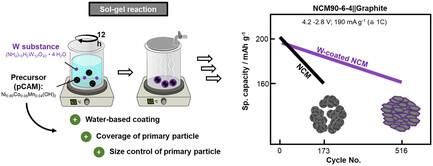超高富镍(90%)层状氧化物基阴极活性材料:在前驱体阴极活性材料中加入钨 (W) 的优势
IF 11.1
Q1 MATERIALS SCIENCE, MULTIDISCIPLINARY
引用次数: 0
摘要
众所周知,少量的钨(W)可改善锂离子电池中富镍层状氧化物基阴极活性材料(CAMs)的性能。在此,通过在溶胶-凝胶反应中改性前驱体 NixCoyMnz(OH)2 (pCAM),或在合成过程中直接改性前驱体 NixCoyMnz(OH)2 (pCAM),即通过基于钨的导管或在连续运行的库埃特-泰勒反应器中进行共沉淀,验证并比较了钨对 LiNi0.90Co0.06Mn0.04O2 (NCM90-6-4)水介质中不同浓度和掺入途径的影响。溶胶-凝胶改性尤其有益,500 次循环后,NCM90-6-4||石墨电池的健康状况≈80%。这可能与均匀的 W 改性表面以及更小和更长的主颗粒有关,而后者被认为能更好地补偿各向异性晶格应力并减少微裂缝数量,从而最大限度地减少表面积的进一步增加和伴随的失效级联(如相变、金属溶解和串扰)。此外,不同的掺入途径会产生不同的结果,这也证明了掺入 W 的复杂性和敏感性。本文章由计算机程序翻译,如有差异,请以英文原文为准。

Ultrahigh Ni-Rich (90%) Layered Oxide-Based Cathode Active Materials: The Advantages of Tungsten (W) Incorporation in the Precursor Cathode Active Material
Minor amounts of tungsten (W) are well known to improve Ni-rich layered oxide-based cathode active materials (CAMs) for Li ion batteries. Herein, W impacts are validated and compared for varied concentrations and incorporation routes in aqueous media for LiNi0.90Co0.06Mn0.04O2 (NCM90-6-4), either via modification of a precursor NixCoyMnz(OH)2 (pCAM) within a sol–gel reaction or directly during synthesis, i.e., either via an W-based educt or during co-precipitation in a continuously operated Couette–Taylor reactor. In particular, the sol–gel modification is shown to be beneficial and reveals >500 cycles for ≈80% state-of-health NCM90-6-4||graphite cells. It can be related to homogeneously W-modified surface as well as smaller and elongated primary particles, whereas the latter are suggested to better compensate anisotropic lattice stress and decrease amount of microcracks, consequently minimizing further rise in surface area and the accompanied failure cascades (e.g., phase changes, metal dissolution, and crosstalk). Moreover, the different incorporation routes are shown to reveal different outcomes and demonstrate the complexity and sensitivity of W incorporation.
求助全文
通过发布文献求助,成功后即可免费获取论文全文。
去求助
来源期刊
CiteScore
14.00
自引率
2.40%
发文量
0
期刊介绍:
Small Science is a premium multidisciplinary open access journal dedicated to publishing impactful research from all areas of nanoscience and nanotechnology. It features interdisciplinary original research and focused review articles on relevant topics. The journal covers design, characterization, mechanism, technology, and application of micro-/nanoscale structures and systems in various fields including physics, chemistry, materials science, engineering, environmental science, life science, biology, and medicine. It welcomes innovative interdisciplinary research and its readership includes professionals from academia and industry in fields such as chemistry, physics, materials science, biology, engineering, and environmental and analytical science. Small Science is indexed and abstracted in CAS, DOAJ, Clarivate Analytics, ProQuest Central, Publicly Available Content Database, Science Database, SCOPUS, and Web of Science.

 求助内容:
求助内容: 应助结果提醒方式:
应助结果提醒方式:


